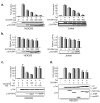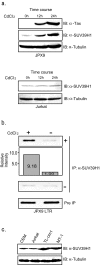SUV39H1 interacts with HTLV-1 Tax and abrogates Tax transactivation of HTLV-1 LTR
- PMID: 16409643
- PMCID: PMC1363732
- DOI: 10.1186/1742-4690-3-5
SUV39H1 interacts with HTLV-1 Tax and abrogates Tax transactivation of HTLV-1 LTR
Abstract
Background: Tax is the oncoprotein of HTLV-1 which deregulates signal transduction pathways, transcription of genes and cell cycle regulation of host cells. Transacting function of Tax is mainly mediated by its protein-protein interactions with host cellular factors. As to Tax-mediated regulation of gene expression of HTLV-1 and cellular genes, Tax was shown to regulate histone acetylation through its physical interaction with histone acetylases and deacetylases. However, functional interaction of Tax with histone methyltransferases (HMTase) has not been studied. Here we examined the ability of Tax to interact with a histone methyltransferase SUV39H1 that methylates histone H3 lysine 9 (H3K9) and represses transcription of genes, and studied the functional effects of the interaction on HTLV-1 gene expression.
Results: Tax was shown to interact with SUV39H1 in vitro, and the interaction is largely dependent on the C-terminal half of SUV39H1 containing the SET domain. Tax does not affect the methyltransferase activity of SUV39H1 but tethers SUV39H1 to a Tax containing complex in the nuclei. In reporter gene assays, co-expression of SUV39H1 represses Tax transactivation of HTLV-1 LTR promoter activity, which was dependent on the methyltransferase activity of SUV39H1. Furthermore, SUV39H1 expression is induced along with Tax in JPX9 cells. Chromatin immunoprecipitation (ChIP) analysis shows localization of SUV39H1 on the LTR after Tax induction, but not in the absence of Tax induction, in JPX9 transformants retaining HTLV-1-Luc plasmid. Immunoblotting shows higher levels of SUV39H1 expression in HTLV-1 transformed and latently infected cell lines.
Conclusion: Our study revealed for the first time the interaction between Tax and SUV39H1 and apparent tethering of SUV39H1 by Tax to the HTLV-1 LTR. It is speculated that Tax-mediated tethering of SUV39H1 to the LTR and induction of the repressive histone modification on the chromatin through H3 K9 methylation may be the basis for the dose-dependent repression of Tax transactivation of LTR by SUV39H1. Tax-induced SUV39H1 expression, Tax-SUV39H1 interaction and tethering to the LTR may provide a support for an idea that the above sequence of events may form a negative feedback loop that self-limits HTLV-1 viral gene expression in infected cells.
Figures






Similar articles
-
Tax relieves transcriptional repression by promoting histone deacetylase 1 release from the human T-cell leukemia virus type 1 long terminal repeat.J Virol. 2004 Jul;78(13):6735-43. doi: 10.1128/JVI.78.13.6735-6743.2004. J Virol. 2004. PMID: 15194748 Free PMC article.
-
SMYD3 interacts with HTLV-1 Tax and regulates subcellular localization of Tax.Cancer Sci. 2011 Jan;102(1):260-6. doi: 10.1111/j.1349-7006.2010.01752.x. Epub 2010 Nov 5. Cancer Sci. 2011. PMID: 21054678
-
Interaction of HTLV-1 Tax and methyl-CpG-binding domain 2 positively regulates the gene expression from the hypermethylated LTR.Oncogene. 2005 Mar 10;24(11):1914-23. doi: 10.1038/sj.onc.1208394. Oncogene. 2005. PMID: 15674330
-
HTLV-1 Tax nucleocytoplasmic shuttling, interaction with the secretory pathway, extracellular signaling, and implications for neurologic disease.J Biomed Sci. 2005 Dec;12(6):961-74. doi: 10.1007/s11373-005-9026-x. Epub 2005 Oct 14. J Biomed Sci. 2005. PMID: 16228291 Review.
-
Transcriptional and post-transcriptional gene regulation of HTLV-1.Oncogene. 2005 Sep 5;24(39):5938-51. doi: 10.1038/sj.onc.1208973. Oncogene. 2005. PMID: 16155601 Review.
Cited by
-
DNA cytosine methylation in the bovine leukemia virus promoter is associated with latency in a lymphoma-derived B-cell line: potential involvement of direct inhibition of cAMP-responsive element (CRE)-binding protein/CRE modulator/activation transcription factor binding.J Biol Chem. 2010 Jun 18;285(25):19434-49. doi: 10.1074/jbc.M110.107607. Epub 2010 Apr 22. J Biol Chem. 2010. PMID: 20413592 Free PMC article.
-
Complete suppression of viral gene expression is associated with the onset and progression of lymphoid malignancy: observations in Bovine Leukemia Virus-infected sheep.Retrovirology. 2007 Jul 23;4:51. doi: 10.1186/1742-4690-4-51. Retrovirology. 2007. PMID: 17645797 Free PMC article.
-
Coactivator-associated arginine methyltransferase 1 enhances transcriptional activity of the human T-cell lymphotropic virus type 1 long terminal repeat through direct interaction with Tax.J Virol. 2006 Oct;80(20):10036-44. doi: 10.1128/JVI.00186-06. J Virol. 2006. PMID: 17005681 Free PMC article.
-
Complex role of microRNAs in HTLV-1 infections.Front Genet. 2012 Dec 17;3:295. doi: 10.3389/fgene.2012.00295. eCollection 2012. Front Genet. 2012. PMID: 23251140 Free PMC article.
-
Epigenetic deregulation of Ellis Van Creveld confers robust Hedgehog signaling in adult T-cell leukemia.Cancer Sci. 2014 Sep;105(9):1160-9. doi: 10.1111/cas.12480. Epub 2014 Sep 8. Cancer Sci. 2014. PMID: 24996003 Free PMC article.
References
-
- Yamaguchi K, Watanabe T. Human T lymphotropic virus type-I and adult T-cell leukemia in Japan. Int J Hematol. 2002;76 Suppl 2:240–245. - PubMed
Publication types
MeSH terms
Substances
LinkOut - more resources
Full Text Sources
Molecular Biology Databases
Research Materials

